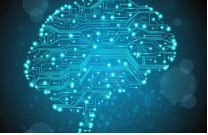Futuristic Brain + Computer Machines May Be Here Very Soon

April 25, 2023
We know that compared to the human brain, supercomputers are weak. Dozens of researchers have reported that the human brain is so much more capable than a machine that us humans are creating. But the time has come to create a new computer, with new advancements. So what project did the John Hopkins University take on?
Creating a supercomputer powered by human brain cells.
Starting from Organoids
Organoids. The word sounds like some sort of bionic AI from a fictional, futuristic movie or book. However, an organoid, while having a fictional concept, is something that is becoming very real today. The picture on the right is a fluorescent picture of an organoid.
An organoid is a small group of cells, about the size of a mark of ink made by a pen being tapped on paper, just once. Some of these get to be around the size of a fruit fly’s brain – which is very small. However, these miniscule beings are in fact capable of imitating brains. They contain neurons – small brain cells – that are used to form electrical signals that transport information to the other parts of the brain, or in this case, the organoid.
The plan is to use these organoids in supercomputers, revolutionizing the computing industry and creating a computer much more capable than the supercomputers of today. The organoid tissues will resemble fully grown organs at a smaller state, so you may have a miniscule brain, or maybe even a super-small heart depending on what the supercomputers will need. Using organoids in supercomputers will be known as OI – organoid intelligence (similar to AI, artificial intelligence).
will need. Using organoids in supercomputers will be known as OI – organoid intelligence (similar to AI, artificial intelligence).
Organoids help humans to ‘hack the system’, letting people experiment on a small brain without having to result in human or animal testing. These organoids are built from a state known as a stem cell – a special type of cell in which it is able to mutate into any type of cell that the body needs. By manipulating these stem cells, scientists have been able to create organoids resembling the form of the human brains.
Implementing the Technology
A supercomputer in Kentucky, known as Frontier, was the first computer to exceed brainpower. Unfortunately, Frontier used one million times more energy to function. Using the OI, supercomputers will be able to function with an incredible speed as well as a better computational capacity.
As of now, humans are able to distinguish simple figures, such as a plant from an animal with only a few different data samples. AI, however, may need thousands or more data samples to complete the same task. With the implementation of organoids, supercomputers would hopefully be able to complete a simple task as such without so many data samples.
 The human brain is also much more energy efficient than a computer. Computers use lots of electricity and power for their processing. Humans, as an example, have around a million times the processing power of a general home computer. Brains use around 1 or 2 watts of power for their computing. In contrast, U.S. data farms use more than 15,000 megawatts of power a year. Using organoid intelligence hand in hand with artificial intelligence, we as humans will be able to save much more energy and power than we currently are.
The human brain is also much more energy efficient than a computer. Computers use lots of electricity and power for their processing. Humans, as an example, have around a million times the processing power of a general home computer. Brains use around 1 or 2 watts of power for their computing. In contrast, U.S. data farms use more than 15,000 megawatts of power a year. Using organoid intelligence hand in hand with artificial intelligence, we as humans will be able to save much more energy and power than we currently are.
The work of human brain cells in computers is already starting to grow. A recent paper in the scientific journal Neuron has found out that a group of brain cells, on its own, was able to learn the well-known video game Pong.
What This Means for the Future
This could help improve governmental data through better computing strategy and less energy required for cloud computing. Additionally, it will help to advance statistical analysis and help researchers get further with their explorations. Many data scientists, astrophysicists, chemists and engineers have needs for supercomputing. These supercomputers are usually unsustainable because they use so much energy. Although, with the implementations of the organoids, supercomputers will be able to compute to astounding levels while using a minimal amount of energy.
Saving energy and power will also help the ecosystems as well. A common US data farm will get most of their energy from burning coal and fossil fuels, an unsustainable and harmful thing for the environment. Using OI will help cut down on greenhouse gas emissions drastically.
And likely the most important effect: aiding doctors. OI will allow insight into the human brain, which means insight into common mental diseases. Doctors will be able to study Alzheimers Disease, dementia and autism without using human samples – leaving the industry cruelty-free. The insight that the organoids provide will most likely help to cure these diseases!
Unfortunately, there is certainly some cause for concern. These organoids could lead to the rise of supercomputers that start to have a mind of their own, and may start to have human-like features in the context of thought and opinion. As long as with the rise of technology, society makes sure that we are controlling it in the best way possible, supercomputers will be a good advancement for the future.
Conclusively, the implementations of organoid intelligence will drastically improve society in many ways. Between helping to save the ecosystem, to aiding in data research as well as helping to cure many mental diseases – as well as keeping it under control – organoids can help our society for the better!
Brain Computers. (n.d.). CNN. https://www.cnn.com/2023/03/04/world/brain-computers-science-newsletter-wt-scn/index.html
O’Neill, M. (2023, March 12). The Future of Computing Includes Biology: AI Computers Powered by Human Brain Cells. SciTechDaily. https://scitechdaily.com/the-future-of-computing-includes-biology-ai-computers-powered-by-human-brain-cells/
Theresa, D. (2023, February 28). Researchers plan supercomputers that are powered by human brain cells. https://interestingengineering.com/innovation/supercomputers-powered-by-brain-cells
IMAGE: Anand Swaroop, Ph.D., NEI/NATIONAL INSTITUTES OF HEALTH/SCIENCE PHOTO LIBRARY & Anand Swaroop, Ph.D., NEI/NATIONAL INSTITUTES OF HEALTH/SCIENCE PHOTO LIBRARY. (2022, September 17). Human retinal organoid, fluorescent micrograph – Stock Image C051/7585. Science Photo Library. https://www.sciencephoto.com/media/1173959/view/human-retinal-organoid-fluorescent-micrograph
IMAGE: Neuroscience News. (2016, April 13). Blurring the Boundary Between Man and Machines: Are Humans the New Supercomputer? https://neurosciencenews.com/gamification-citizen-science-4046/
IMAGE: S. (2021a, April 2). The Architecture of Thought: Part 4—A Brain-y Supercomputer. Science You Can Bring Home to Mom. https://anyonecanscience.com/index.php/2021/04/02/the-architecture-of-thought-part-4-a-brain-y-supercomputer/
IMAGE: T. (2021b, January 28). What is Blue Brain Technology? Techslang — Tech Explained in Simple Terms. https://www.techslang.com/definition/what-is-blue-brain-technology/




